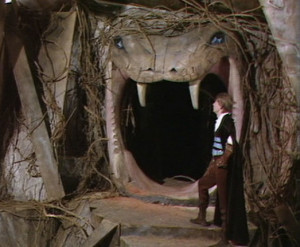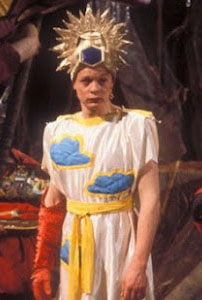 When Tegan unconsciously sets the TARDIS coordinates for Manussa, a planet once ruled by the Mara (the snake creature from last season’s Kinda), the Doctor realizes the creature still has possession of her mind. His early attempts to prevent it from taking control of her prove futile, and he has to figure out why the Mara has brought them all to this point in time, in hopes of stopping whatever it has planned.
When Tegan unconsciously sets the TARDIS coordinates for Manussa, a planet once ruled by the Mara (the snake creature from last season’s Kinda), the Doctor realizes the creature still has possession of her mind. His early attempts to prevent it from taking control of her prove futile, and he has to figure out why the Mara has brought them all to this point in time, in hopes of stopping whatever it has planned.
Manussa is a backwater world in an interplanetary Federation. Once, it was the head of an empire of its own, ruled over by the Mara, until 500 years ago the creature was defeated by the ancestor of the present “Federator,” the hereditary monarch of the Federation. On the eve of the once-every-ten-years celebration of that event, the Federator’s bored, spoiled son Lon is on the planet with his mother to attend the ceremony. The Mara has plans that this year’s ceremony will mark its return to power.
It’s impossible to reconcile what we learn about the Mara in this story with the way its presented in Kinda, but that doesn’t matter: this is a good story which, although revisiting the same spiritual/Buddhist themes as its predecessor stays more firmly on science fiction ground by giving us an origin of the Mara in the advanced technology of the ancient Manussan civilization (they created a crystal that could convert thoughts into reality, and it accidentally produced the Mara in the same way as the “Id Monster” from Forbidden Planet). The story does good world-building with Manussa. In the TARDIS, Nyssa looks up the planet and finds it now makes most of its money from tourism, and when our heroes go out that’s what they find: what must once have been a solemn “never forget” ceremony commemorating the freeing of the planet from rule by a literal demon has now become a tawdry tourist exhibit, with a bustling bazaar where merchants hawk cheap plastic snake statues and a carnival barker entices the tourists to confront the darkness in their innermost selves— in his hall of mirrors funhouse.
Meanwhile the governor of the planet is charged with keeping the traditions alive— almost certainly a vitally important duty once, in the immediate aftermath of the Mara’s defeat— but in the 500 years since has become nothing but the keeper of an antiquities museum. The current incumbent is a classic old fuddy-duddy, waxing rhapsodic about the magnificent artistry of various artifacts from this period or that, but completely contemptuous of anyone who considers taking the old legends seriously.
The Federation representatives consist of the spoiled teenage brat Lon and his overindulgent mother. Within five minutes of meeting him you’re wishing someone would smack him in the face. These two characters are both perfectly believable as mother and son but also as the royals of an empire in decay. Lon is the heir to the throne— but sees it as a massive imposition to be asked to take an interest in the history he’s there to commemorate, and would much rather ostentatiously display his disdain for it all.
Into this the Doctor’s desperate attempts to warn everyone that the Mara is going to return in the middle of the ceremony are never going to get much reaction. He’s dismissed as a crank, to his increasing frustration, while everyone blithely moves toward disaster— and this builds in nicely to the climax, where he learns that to defeat the Mara he has to set aside all the frustration that’s been building for the whole episode, along with his guilt over what’s happened to Tegan, and instead just be still— probably the hardest challenge any Doctor could be asked to meet.
Tegan, meanwhile, gets to play the villain for a lot longer than she did when previously possessed by the Mara in Kinda (where it jumped from her into someone else after only a few minutes). In this story, once separated from the Doctor she gets to play lead villain for most of the episode, first recruiting the carnival barker as a henchman and then taking control of Lon himself.
The giant snake effects at the climax of the story are a great improvement over Kinda but still let the story down a bit. However, that’s part of the reality of pre-CGI Dr Who. Set and costume designs are very nice and play well into the world-building from the writer: the tourist bazaar on Manussa, along with the Manussan costumes, are based on a visit to a marketplace in Morocco the designer had visited (with other costumes following a semi-Ottoman-empire theme) while the costumes for the Federation representatives have a vaguely Roman-aristocrat look. Even the much-mocked ceremonial costume Lon wears when reenacting his ancestor’s role in defeating the Mara works within the context of the story— it looks ridiculous but in exactly the way that it should (but see below).
Overall, Snakedance is a good outing for the Fifth Doctor and crew, and in my opinion a better story exploring the Mara than Kinda. Kinda was good, too, in its own odd way, but Snakedance moves the Mara into better territory as a Dr Who monster. It’s a pity this was its last appearance (in official Dr Who, anyway).
Details
 The role of Lon was the first television appearance for actor Martin Clunes, who went on to considerable success and respect as a BBC actor. Any time there’s an entertainment news about Clunes, it’s obligatory to embarrass him with a picture of the ceremonial costume he wore at the end of Snakedance, a tradition I choose to respect by including the picture at right. It does actually fit the story, where its garishness combines some clear ritual/ceremonial motifs (the mythic hero who defeated the Mara being depicted as the Sun) with the general kitschiness into which the whole ceremony has descended.
The role of Lon was the first television appearance for actor Martin Clunes, who went on to considerable success and respect as a BBC actor. Any time there’s an entertainment news about Clunes, it’s obligatory to embarrass him with a picture of the ceremonial costume he wore at the end of Snakedance, a tradition I choose to respect by including the picture at right. It does actually fit the story, where its garishness combines some clear ritual/ceremonial motifs (the mythic hero who defeated the Mara being depicted as the Sun) with the general kitschiness into which the whole ceremony has descended.- Not pictured, a new costume for Nyssa, who finally sheds her velvet Traken outfit— unfortunately for a costume that’s just as ridiculous as Lon’s, only without the story justification (other than, perhaps, Nyssa having no more idea than the Doctor what Earth people really wear).
- JN-T promised the return of an old monster for every story of season 20. While the Mara technically qualifies, I do have to raise an objection: it was introduced in an episode only the previous season, which hardly counts as a blast from the past. As we’ll see going on, the promise of a season devoted to Dr Who’s history isn’t really going to work out.
Next Week:
“Mawdryn Undead,” 4 episodes.

